SSR (Secondary Surveillance Radar) Modes refer to different operational modes or functionalities of the secondary radar system used in air traffic control and military identification systems. These modes enable the radar system to perform various tasks such as identifying, tracking, and communicating with aircraft equipped with transponders.
What are SSR Modes?
SSR/IFF (Secondary Surveillance Radar/Identification Friend or Foe) modes are specific operational modes used in radar systems for air traffic control and military identification purposes. These modes help in identifying aircraft and exchanging information between interrogators and transponders.
SSR Modes.
IFF/SSR, or Identification Friend or Foe/Secondary Surveillance Radar, operates on two frequencies: 1030 MHz for interrogation and 1090 MHz for the reply. The system encompasses various modes designated by both military and civilian authorities:
- Military modes are labeled Modes 1, 2, 3, 4, and 5.
- Civil ATC modes are denoted as Modes A, B, C, D, and S.
Some modes share identical waveforms, such as Military Mode 3 and Civil Mode A, both referred to as Mode 3/A.
Here’s a list of the SSR modes and their usage:
- Mode 4, once used in military operations, is now replaced by the more secure Mode 5.
- FAA regulations mandate that aircraft flying above 10,000 feet in controlled airspace must have an operational transponder capable of automatic altitude reporting (Mode C).
- Each interrogation mode gathers specific information from the aircraft.
- Mode S ADS-B, UAT, Mode 5 Level 2, and Level 2B provide non-solicited transponder squitter reports.
- Legacy Mode 1 provides 32 reply codes and is used in military air traffic control for aircraft or mission type identification.
- Mode 2, also military-used, offers 4096 possible reply codes for individual aircraft identification.
- Mode 3/A, standard for ATC/IFF, provides positive control for aircraft flying under Instrument Flight Rules (IFR) by assigning unique codes. General aviation aircraft flying under visual flight rules use a common code of 1200.
- Mode C enables automatic altitude reporting.
- Modes B and D have limited use and won’t be discussed.
- Mode 5, the new military secure mode, has replaced Mode 4 and addressed its operational issues.
- Modes 1, 2, 3/A, and C are collectively known as Selective Identification Feature (SIF) Modes.
SIF/ATCRBS Modes.
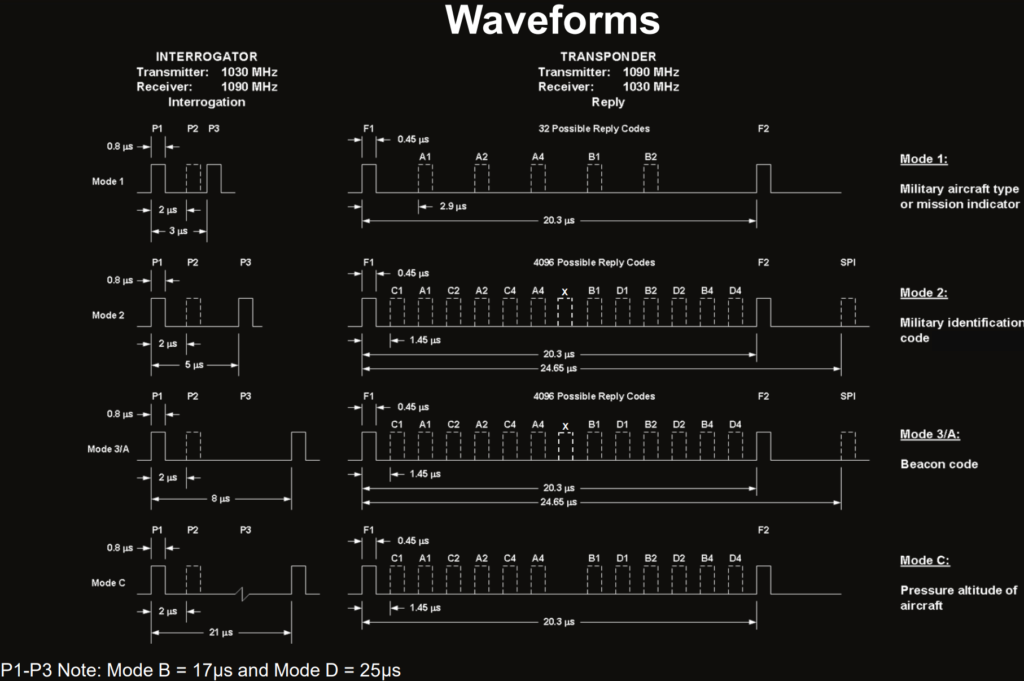
SIF/ATCRBS Modes include several features:
Special Position Indicator (SPI).
- When air traffic controllers request aircraft identification (‘ident’), the SPI activates for about 18 seconds, highlighting the transponder on the controller’s display for confirmation.
- In Mode 1, the SPI consists of 2-F1/F2 brackets separated by 24.65µs.
- For Mode 2 and 3/A, the SPI pulse occurs 4.35µs after the F2 pulse, activated by the “Squawk Ident” command from air traffic control.
- Mode S transponders also offer SPI capability.
Emergency Codes and Conditions.
- Hijack (7500), Communication Failure (7600), and Emergency (7700) codes.
- In Modes 2 and 3/A, a 4-F1/F2 Bracket Military Emergency signal, separated by 24.65µs, indicates a military emergency.
X-Pulse (XP).
- Indicates special aircraft, possibly drones.
- Traditionally used to identify Bomarc missiles.
Mode S Introduction.
Mode S, short for Mode Select, is an advanced surveillance and communication technology used in aviation. It represents a significant improvement over traditional secondary surveillance radar (SSR) systems.
- Almost all commercial air traffic currently utilizes Mode S transponders.
- Mode S transponders are increasingly becoming mandatory for access to unrestricted airspace.
- They are essential for collision avoidance systems.
- Basic surveillance using Mode S is required in Europe.
- Enhanced surveillance capabilities are also mandated in Europe.
- The US is reviewing applications of Mode S for homeland security and defense purposes.
Mode S Benefits and Strategy.
Benefits of Mode S are:
- Roll-calls: With individual addressing of each target, there’s a reduced chance of garbled responses.
- All-Calls: Once a target is acquired and lock-out is maintained, it won’t respond to all-calls from that interrogator identification (II) code. This reduces RF pollution and improves transponder availability.
- Additional Mode S Strategies:
- Stochastic Acquisition: Interrogations can be coded to prompt transponders to respond to all-calls at a lower probability, reducing garble for closely spaced targets.
- Lockout Override: Interrogations can be coded to force transponders to respond to all-calls, even if they are locked out (typically used with II code 0).
Mode S Waveforms.
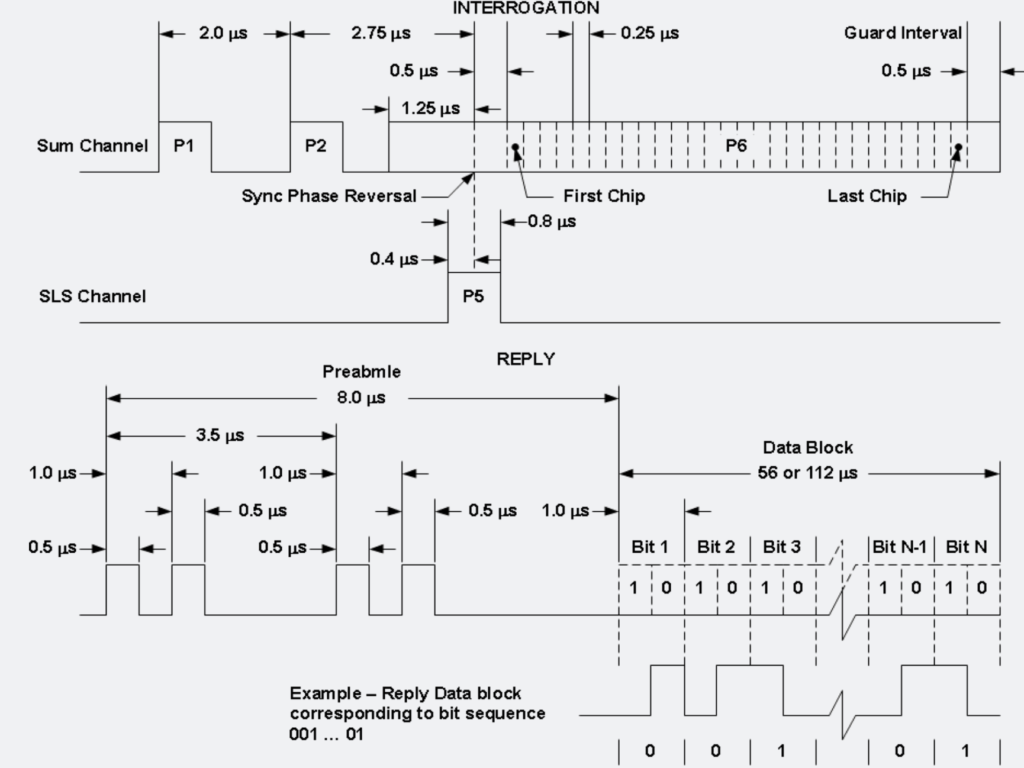
Mode S Capabilities.
Capabilities of Mode S:
- Enhancement of Secondary Surveillance Radar (SSR): Mode S improves upon traditional SSR by overcoming its limitations and offering additional features.
- Selective Addressing: Mode S allows for selective addressing of individual Mode S transponder-equipped targets.
- Unique ICAO 24-bit Address: Each Mode S target has a unique 24-bit address, which must be acquired by the Mode S Interrogator before selective addressing.
- Acquisition Process: The Interrogator uses Mode S All-Call interrogations to acquire Mode S addresses.
- Data Link Capability: Mode S enables a data link between a Mode S target and Interrogator once the target is acquired. This allows for selective interrogations and downlink of aircraft parameters (DAPs).
- Interrogator Codes: There are 15 II-codes and 63 SI codes, with II = “0” typically reserved for mobile interrogators.
- Selective Addressing: The ICAO aircraft address consists of 24 bits, providing over 16 million possible codes.
- Acquisition and Lockout: Interrogators use “All-Calls” to initially acquire targets, then maintain surveillance through subsequent “roll-calls” that individually address each target. Once acquired, targets can be locked out from responding to further “all-calls” from that specific Interrogator, with a lock-out duration of 18 seconds.
Mode 5 Introduction.
Mode 5 offers significant operational and performance enhancements compared to Mode 4:
- Four Operational Levels: Mode 5 defines four operational levels using two waveform classes:
- L1, Q&A: This synchronous mode, triggered by interrogations, incorporates Processing Gain and includes an Aircraft Unique PIN for enhanced security.
- L2, Position Reporting: This asynchronous mode includes Processing Gain and provides additional information such as Aircraft Position and Other Attributes.
- L3, Selective Interrogation: Reserved for future use, this mode can be synchronous or asynchronous.
- L4, Extended Data: Also for future use, this asynchronous mode offers a high data rate.
- Advanced Features: Mode 5 employs Enhanced Encryption, Spread Spectrum Modulation, and Time of Day Authentication for heightened security and reliability.
- Standards and Specifications: Mode 5 is specified in NATO STANAG 4193 and DOD-AIMS 17-1000, ensuring interoperability among allied and coalition forces.
- Security Assurance: Mode 5 includes COMSEC (Communications Security) specifications and interface control documents outlining the new cryptographic algorithm and time-dependent authentication and data encryption features.
- Certification Process: The DoD AIMS Program Office certifies IFF systems to ensure interoperability and compliance with Mode 5 standards.
Mode 5 Addresses Mode 4 Deficiencies.
Mode 5 has superseded Mode 4 as the latest crypto-secure military identification system.
- Key Features:
- High-Confidence Identification: Mode 5 ensures reliable identification of friendly air, ground, and surface targets even in densely populated target environments.
- Real-Time Situational Awareness: It offers instantaneous situational awareness through GPS/INS position reporting, enabling precise tracking of targets.
- Secure Data Transfer: Mode 5 facilitates secure data exchange between platforms, enhancing communication and coordination.
- Additional Benefits:
- Private-Channel Capability: Mode 5 supports private-channel communication, ensuring secure and confidential exchanges.
- Increased Identification Range: It extends the range over which identification can be reliably achieved, enhancing operational effectiveness.
- Reduced Operator Workload: Mode 5 streamlines operations and reduces the workload on operators, allowing them to focus on critical tasks.
- Minimized Civil ATC Interference: By reducing interference with civilian Air Traffic Control (ATC), Mode 5 promotes smoother coordination and safer airspace management.
Mode 5 Operational Objectives and Benefits.
The goals of Mode 5 are to:
- Prevent Fratricide: Ensure high confidence, accurate, and continuous identification of friendly forces to prevent accidental attacks.
- Enhance Positive Identification: Improve identification capabilities even at maximum weapons engagement range, extending coverage, reducing target dropouts, and eliminating weaknesses seen in previous identification systems.
- Increase Reaction Times: Provide faster reaction times by offering higher-quality long-range identification of targets.
- Separate Closely Spaced Targets: Enable the differentiation of closely spaced targets within a single scan, eliminating the need for complex procedures like leader squawk and related track swaps.
- Ensure Modern Security: Offer modern security features to safeguard against unauthorized access or manipulation of identification data.
- Compatibility with Civil ATC: Ensure compatibility with civil Air Traffic Control systems to maintain smooth and safe airspace management.
- Interoperability: Facilitate interoperability with NATO and allied forces to ensure seamless communication and coordination across different military entities.
Mode 5 Interrogation Waveform.

Mode 5 Reply Waveform.
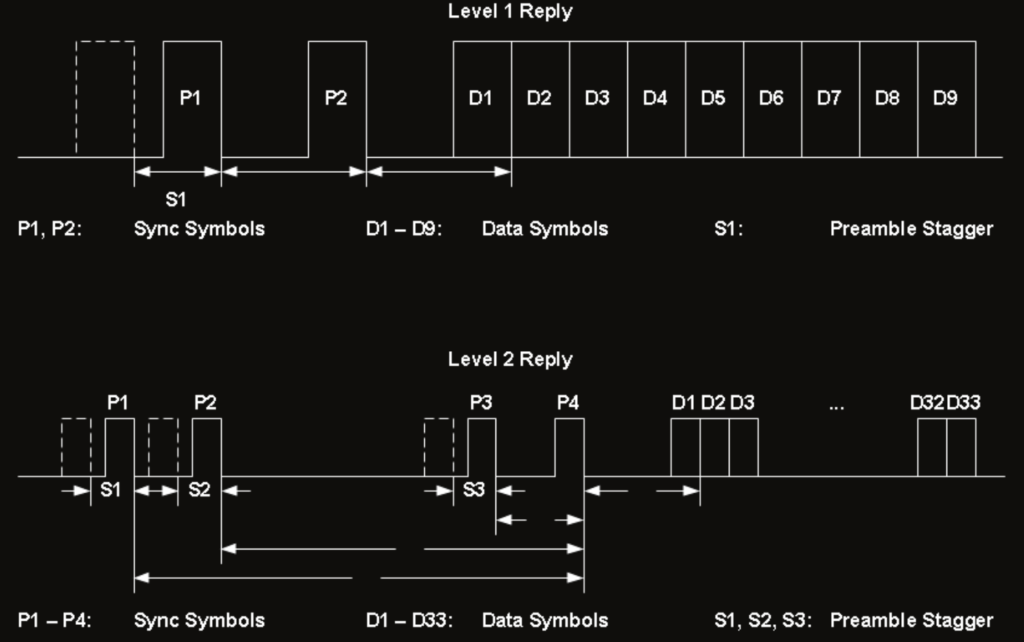
Mode 5 Formats.
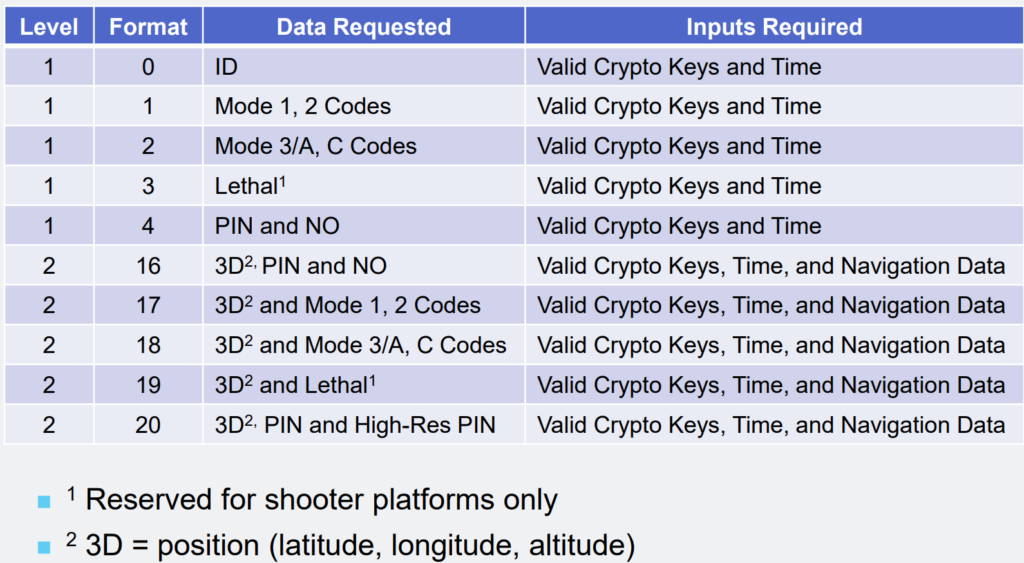
Mode 5 Level 1, Improved Q&A Identification.
Mode 5 offers secure friend-from-friend identification through several features:
- Extensive Code Options: It provides a vast array of PIN codes (16k) and National Origin (NO) Codes (2048) to ensure secure and unique identification of friendly forces.
- Compatibility: Mode 5 supports various identification modes such as Mode 1, 2, 3/A, C, I/P, X, and emergency data, ensuring comprehensive identification capabilities across different scenarios.
- Lethal Engagement Signaling: It includes a feature to indicate engagement intent, enhancing situational awareness and response capabilities during critical situations.
- High Confidence Identification: Mode 5 ensures high-confidence identification in any scenario by offering improved probability of identification (P-id) and increased system capacity. It extends the identification range with modest processing gain while addressing shortcomings seen in previous identification systems like mutual interference, garbling, exploitation, and spoofing.
- Reduced Interference to Civil ATC: The message structure of Mode 5 is specifically designed to minimize interference with civil Air Traffic Control systems. Interrogation rates are also reduced to less than half compared to previous systems like Mark XII, further reducing the chances of interference.
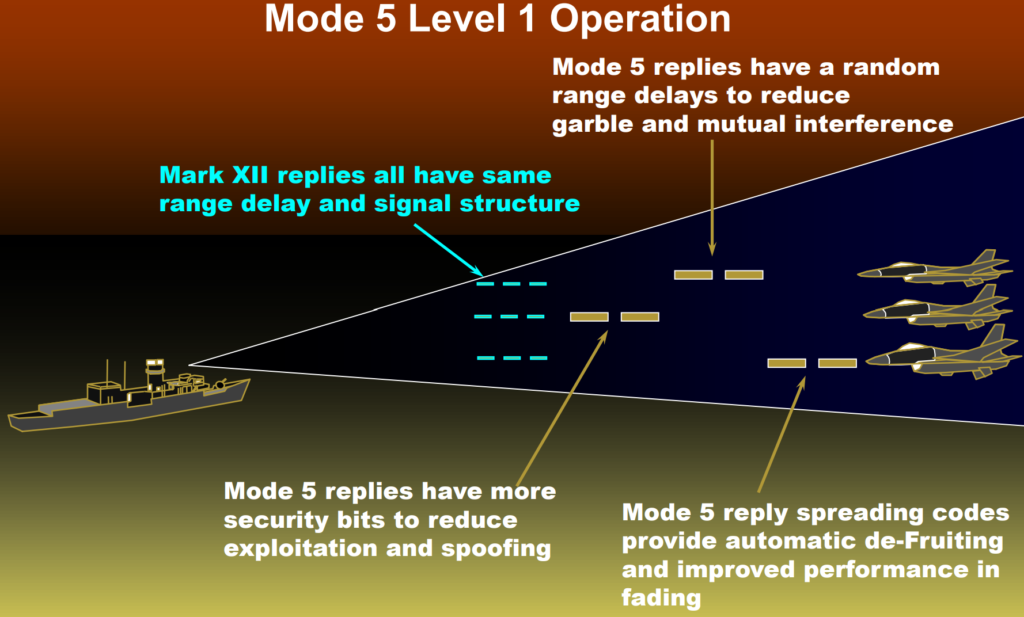
Mode 5 Level 1 Performance.
Here’s the parameter performance comparison between Mode 4 and Mode 5.
| Parameter | Mode 4 | Mode 5 |
|---|---|---|
| Probability of ID. | Less reliable | Significant improvement |
| Range Accuracy. | Moderate | Four times improvement |
| Azimuth Accuracy | Similar | Similar |
| Range Resolution. | Limited by lower limit | No lower limit |
| Azimuth Resolution | Limited by lower limit | No lower limit |
| Link Margin. | Standard | Approximately 2x improvement |
| Target Data. | Limited | Non-garbled, comprehensive |
| Security. | Basic | Enhanced, supports continuous interrogation mode |
| ATC Compatibility. | Compatible | Compatible |
| Radar Correlation. | Moderate | Improved |
This table provides a concise comparison between Mode 4 and Mode 5 across various parameters, highlighting the advancements and improvements offered by Mode 5 over its predecessor.
Mode 5 Level 2 Situation Awareness.
Mode 5 Level 2 provides for passive detection and triggered detection. It allows position reports to convey secure position and identification, including GPS/INS position reporting by aircraft, ground, and surface vehicles. These reports include Mark XII data, platform PIN, and mission code. Reports are transmitted when interrogated and randomly as Squitters.
Mode 5 Level 2 identifies and locates friends with only one report, offering much higher probability of detection (Pd) and system capacity. It supports relative GPS accuracy between platforms.
Additionally, Mode 5 Level 2 improves radar correlation significantly, providing four orders of magnitude improvement in correlation volume.
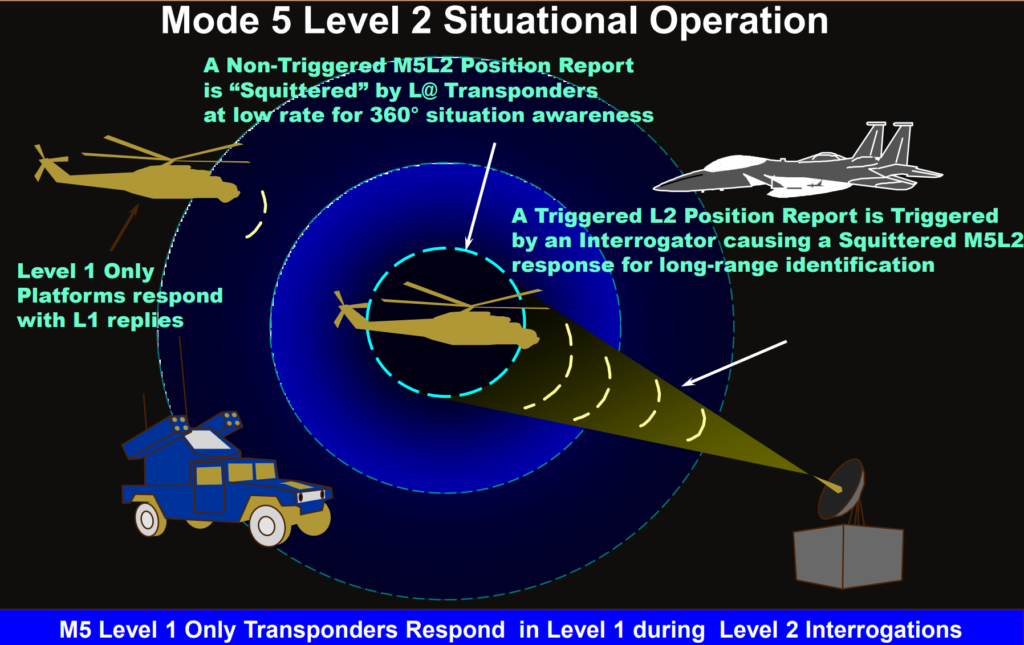
Mode 5 Level 2 Passive Reception Performance.
| Parameter | Performance |
|---|---|
| Situational Awareness | Provides comprehensive situational awareness. |
| Range | – Approximately 50 NM with typical antennas. – Can be significantly improved with multi-channel systems and high-gain antennas like the Telephonics AN/UPR-4(V) PDRS. |
| Resolution | – Latitude: 250 ft. – Longitude: 250 ft. – Altitude: 50 ft. |
| Accuracy – Relative GPS | Offers high accuracy in relative GPS positioning. |
| Probability of ID | Greater than 99%, ensuring highly reliable identification. |